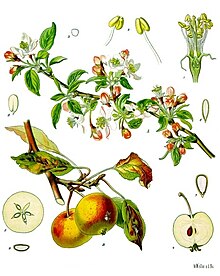The
apple is the pomaceous fruit of the apple tree, species
Malus domestica in the rose family (Rosaceae). It is one of the most widely cultivated tree fruits, and the most widely known of the many members of genus
Malus that are used by humans. Apples grow on small, deciduous trees. The tree originated in Western Asia, where its wild ancestor,
Malus sieversii,
is still found today. Apples have been grown for thousands of years in
Asia and Europe, and were brought to North America by European
colonists. Apples have been present in the mythology and religions of
many cultures, including Norse, Greek and Christian traditions. In 2010, the fruit's genome was decoded, leading to new understandings of disease control and selective breeding in apple production.
There are more than 7,500 known cultivars
of apples, resulting in a range of desired characteristics. Different
cultivars are bred for various tastes and uses, including in cooking, fresh eating and cider production. Domestic apples are generally propagated by grafting, although wild apples grow readily from seed. Trees are prone to a number of fungal, bacterial and pest problems, which can be controlled by a number of organic and non-organic means.
About 69 million tonnes of apples were grown worldwide in 2010, and
China produced almost half of this total. The United States is the
second-leading producer, with more than 6% of world production. Turkey
is third, followed by Italy, India and Poland. Apples are often eaten
raw, but can also be found in many foods (especially desserts) and
drinks. Many beneficial health effects have been found from eating
apples; however, the seeds are slightly poisonous and two forms of
allergies are seen to various proteins found in the fruit.
Botanical information

Blossoms, fruits, and leaves of the apple tree (
Malus domestica)
The apple forms a tree that is small and deciduous, reaching 3 to 12 metres (9.8 to 39 ft) tall, with a broad, often densely twiggy crown.
[2] The leaves are alternately arranged simple ovals 5 to 12 cm long and 3–6 centimetres (1.2–2.4 in) broad on a 2 to 5 centimetres (0.79 to 2.0 in) petiole with an acute tip, serrated margin and a slightly downy underside. Blossoms
are produced in spring simultaneously with the budding of the leaves.
The flowers are white with a pink tinge that gradually fades, five petaled,
and 2.5 to 3.5 centimetres (0.98 to 1.4 in) in diameter. The fruit
matures in autumn, and is typically 5 to 9 centimetres (2.0 to 3.5 in)
in diameter. The center of the fruit contains five carpels arranged in a five-point star, each carpel containing one to three seeds, called pips.
[2]
Wild ancestors
Main article: Malus sieversii
The original wild ancestors of
Malus domestica was
Malus sieversii, found growing wild in the mountains of Central Asia in southern Kazakhstan, Kyrgyzstan, Tajikistan, and Xinjiang, China.
[3] Cultivation of the species, most likely beginning on the forested flanks of the Tian Shan mountains, has progressed over a long period of time and permitted secondary introgression of genes from other species into the open-pollinated seeds, including such a large amount of gene exchange with
Malus sylvestris,
the crabapple, that current populations of apples are more related to
those of crabapples than to the more morphologically similar progenitor
Malus sieversii, though in pure strains without recent admixture the contribution of the latter predominates.
[4][5][6]
Genome
In 2010, an Italian-led consortium announced they had decoded the complete genome of the apple in collaboration with horticultural genomicists at Washington State University,
[7] using the Golden delicious variety.
[8] It had about 57,000 genes, the highest number of any plant genome studied to date
[9] and more genes than the human genome (about 30,000).
[10]
This new understanding of the apple genome will help scientists in
identifying genes and gene variants that contribute to resistance to
disease and drought, and other desirable characteristics. Understanding
the genes behind these characteristics will allow scientists to perform
more knowledgeable selective breeding. Decoding the genome also provided
proof that
Malus sieversii was the wild ancestor of the domestic apple—an issue that had been long-debated in the scientific community.
[11]

Tidak ada komentar:
Posting Komentar